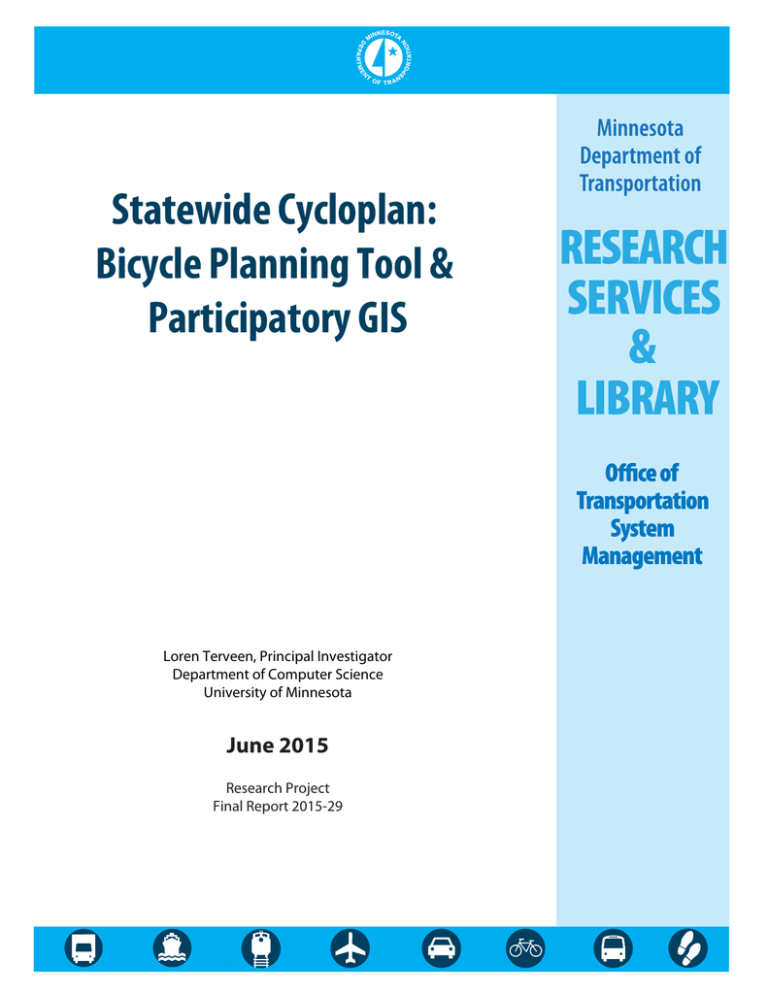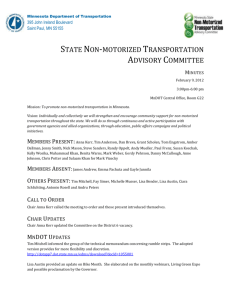Statewide Cycloplan: Bicycle Planning Tool & Participatory GIS
advertisement

Statewide Cycloplan: Bicycle Planning Tool & Participatory GIS Loren Terveen, Principal Investigator Department of Computer Science University of Minnesota June 2015 Research Project Final Report 2015-29 To request this document in an alternative format call 651-366-4718 or 1-800-657-3774 (Greater Minnesota) or email your request to ADArequest.dot@state.mn.us. Please request at least one week in advance. Technical Report Documentation Page 1. Report No. 2. 3. Recipients Accession No. MN/RC 2015-29 4. Title and Subtitle 5. Report Date Statewide Cycloplan: Bicycle Planning Tool & Participatory GIS June 2015 7. Author(s) 8. Performing Organization Report No. 6. Loren Terveen 9. Performing Organization Name and Address 10. Project/Task/Work Unit No. Department of Computer Science and Engineering University of Minnesota 4-192 Keller Hall, 200 Union Street S.E. Minneapolis, MN 55455-0159 CTS #2012050 12. Sponsoring Organization Name and Address 13. Type of Report and Period Covered Minnesota Department of Transportation Research Services & Library 395 John Ireland Boulevard, MS 330 St. Paul, Minnesota 55155-1899 Final Report 11. Contract (C) or Grant (G) No. (c) 99008 (wo) 35 14. Sponsoring Agency Code 15. Supplementary Notes http://www.lrrb.org/pdf/201529.pdf 16. Abstract (Limit: 250 words) This project extended the existing Cyclopath and Cycloplan bicycle routing and planning system. The primary goal of this project was to develop a statewide bicycle map. The map was intended to serve multiple purposes, including: • • • • Giving people throughout Minnesota easy access to bicycle routing information, thus making it easier for them to utilize bicycling as transportation; Supporting long-distance bicycle travel and bicycle travel outside of urban areas; Compiling disparate sets of bikeways data -- from different sources and in different formats -- into a single, unified dataset and tool; Serving as a collaborative tool for public participation and inter-agency cooperation. We achieved these goals by working closely with relevant stakeholders – both end users and planners – over the life of this project. The result is a version of Cyclopath that: • • • Enables bicycle routing for the entire state of Minnesota; Features a significantly simplified and improved end-user interface; Adds useful new features for transportation planners. 17. Document Analysis/Descriptors 18. Availability Statement Bicycling, Routes and routing, Geographic information systems, Mapping, Public participation No restrictions. Document available from: National Technical Information Services, Alexandria, Virginia 22312 19. Security Class (this report) 20. Security Class (this page) 21. No. of Pages Unclassified Unclassified 15 22. Price Statewide Cycloplan: Bicycle Planning Tool & Participatory GIS Final Report Prepared by: Loren Terveen Department of Computer Science University of Minnesota June 2015 Published by: Minnesota Department of Transportation Research Services & Library 395 John Ireland Boulevard, MS 330 St. Paul, Minnesota 55155-1899 This report represents the results of research conducted by the authors and does not necessarily represent the views or policies of the Minnesota Department of Transportation or the University of Minnesota. This report does not contain a standard or specified technique. The authors, the Minnesota Department of Transportation, and the University of Minnesota do not endorse products or manufacturers. Trade or manufacturers’ names appear herein solely because they are considered essential to this report ACKNOWLEDGMENTS I thank everyone who has worked on this project, especially the following: Landon Bouma, the software engineer for my group, who did incredible amounts of problem solving, programming, and design; Reid Priedhorsky, who co-founded Cyclopath and designed and implemented nearly the entire system originally; Mikhil Masli, who contributed significantly to user research and design and implementation work involved in this project; Greta Alquist, who was the first technical liaison for this project; and Jasna Hadzic, who was the second technical liaison. TABLE OF CONTENTS Chapter 1: Introduction: Background and technical challenges ..................................................... 1 Chapter 2: The Problem of Data Integration................................................................................... 3 2.1 Segmentization ...................................................................................................................... 3 2.2 Solution ................................................................................................................................. 4 2.3 Integrating Regional and State Trails ................................................................................... 5 Chapter 3: User Interface Redesign and system engineering ......................................................... 6 Chapter 4: Conclusions ................................................................................................................... 8 LIST OF FIGURES Figure 1 Current Cyclopath Landing Page. ................................................................................... 2 Figure 2: The "Segmentization" Problem Illustrated. ..................................................................... 4 EXECUTIVE SUMMARY This project extended the existing Cyclopath and Cycloplan bicycle routing and planning system. The primary goal of this project was to develop a statewide bicycle map. The map was intended to serve multiple purposes, including: • • • • Giving people throughout Minnesota easy access to bicycle routing information, thus making it easier for them to utilize bicycling as transportation Supporting long-distance bicycle travel and bicycle travel outside of urban areas Compiling disparate sets of bikeways data – from different sources and in different formats – into a single, unified dataset and tool Serving as a collaborative tool for public participation and inter-agency cooperation. We achieved these goals by working closely with relevant stakeholders – both end users and planners – over the life of this project. The result is a version of Cyclopath that: • • • Enables bicycle routing for the entire state of Minnesota Features a significantly simplified and improved end-user interface Adds useful new features for transportation planners. CHAPTER 1: INTRODUCTION: BACKGROUND AND TECHNICAL CHALLENGES At the beginning of this project, Cyclopath already was a mature bicycle routing system for the 7-county Twin Cities Metro Area. It had been developed over a period of about four years, using significant funding from the National Science Foundation, The University of Minnesota, The Minnesota Department of Transportation, and The Metropolitan Council. One full-time software engineer, 5 PhD students, and about 5 undergraduate and Masters students contributed to the system design and implementation. The original version of Cyclopath was designed for bicyclists, and it featured several important innovations: • • It was a geographic wiki; a map that anyone could edit. The motivation for this was that cyclists had knowledge not reflected in “official” road and trail maps, ranging from informal paths they used (e.g., important shortcuts through parks) to their evaluations and ratings of road and trail segments. It offered intelligent personalized routing; using techniques from search and recommender systems, Cyclopath could compute routes for cyclists that satisfied their personal preferences, e.g., utilizing only off-road trails, minimizing distance, or avoiding hills. With previous funding from MnDOT, we extended Cyclopath to enable multimodal routing, i.e., routes that combined both biking and public transit. And with previous funding from the Metropolitan Council, we extended Cyclopath to add features to support transportation planners, e.g., to enable them to analyze the entire database of (10s of thousands of) route requests to identify inefficiencies in the existing network of bicycle facilities. In this project, we took on the challenge of extending Cyclopath to work for the entire state of Minnesota. This raised a number of technical challenges that we had to solve: • • • • • We had to obtain several relevant bikeways datasets and translate them into a format usable by Cyclopath. We had to merge road geometry and metadata to enable unified routing; We modified the user interface to make it simpler and easier to use as well as faster; we did this in part by separating out map editing functionality, which users could access with the press of a button; We had to engineer Cyclopath to statewide scale; this included adding several new “zoom layers” to enable map viewing at larger geographic scales and modifying our routing algorithm to enable long-distance routing; We had to move our code to a new server to handle larger amounts of data and more demanding computational requirements. 1 We carried out the work of this project in close collaboration with stakeholders from MnDOT and other relevant partners, including holding a number of design and prototyping sessions that greatly influenced the revised design of Cyclopath. Figure 1shows the current Cyclopath landing page, i.e., the view users get when they first enter the system. In the remainder of this report, we describe the main technical challenges we had to solve to reach this point and detail the user interface development process we followed and the design changes we made. Figure 1 Current Cyclopath Landing Page. 2 CHAPTER 2: THE PROBLEM OF DATA INTEGRATION We describe some of the key technical challenges we solved in integrating statewide trail and road data into the original 7-county-metro-area Cyclopath database. First, let us consider the challenges through a consideration of a geographic database that we received from MnDOT (in June 2013). The database contained a line segment layer called “Roadway_Char” that represents the state roadway network, and it includes useful attributes: Shoulder type and width (which Cyclopath uses to indicate if a shoulder is considered “bikeable”, i.e., if it's 4 feet or wider). • • • Controlled access or not (which is used to indicate if a roadway is open to bicyclists, and used to guess if an intersection exists with another road when segmenting line segments; see discussion below). Number of lanes (used to guess a road's “bikeability”, its appeal to the average/casual cyclist). Direction of travel (used by the route finder so it doesn't send cyclists the wrong way down a street). But importing this data into Cyclopath was difficult: • • Line segments were not “segmentized”, that is, split at intersections with other line segments. Road names were obscure and not useful for cyclists; e.g., in Duluth, you'll find line segments with attributes like, ROAD_NAME: “M457”, and DESCRIPTION: “7TH ST E MSAS-217 XING”. 2.1 Segmentization This figure below illustrates the segmentization problem: one line segment is selected, shown highlighted in green. This segment goes for ten blocks. We can see that it intersects 9 other roads, but in the database, its only connections to the rest of the roads are its two endpoints. If we simply imported this data “as is”, the Cyclopath route finder could only route cyclists between the two endpoints (ten blocks apart) and would not be able to route a cyclist to any of the nine intersecting streets. 3 Figure 2: The "Segmentization" Problem Illustrated. There may seem to be an obvious solution to this problem: when we integrate new data, write code to check the geometry of each segment against existing data, and wherever the geometries intersect, create a connection in the database. In the above example, this would result in correctly adding the 8 intermediate intersections. However, there are many cases where this is not the right thing to do: for example, a bicycle trail might pass over a highway on a bridge, thus the trail and road are not connected. Further, the data we received for importation also had many so-called “dangles”, line segment endpoints that do not connect to the rest of the road network. 2.2 Solution We solved these problems (and a few other related, less common ones) through a combination of automated and manual methods • • We developed custom software to intelligently create intersections where line segments intersect; for example, the software would not create intersections where a controlled access road intersects another road. We recorded metadata about the new intersections so that a human operator can audit the changes. We manually audited the added intersections in Cyclopath for accuracy. 4 2.3 Integrating Regional and State Trails The MnDot data did not include regional or state bike trails, or any bike facility-specific attributes. To get this data, we obtained a statewide geodatabase of bicycle and recreational trails published by the College of Design (http://ccl.design.umn.edu/mnpat.html). This dataset was compiled from many different sources, including regional, state, and federal agencies. Much of this data is very useful for statewide bicycle travel. For example, the data includes the Willard Munger Trail, which connects cyclists from Hinkley to Duluth. We integrated this dataset into Cyclopath using the same methods described above. 5 CHAPTER 3: USER INTERFACE REDESIGN AND SYSTEM ENGINEERING Our goals were to make the Cyclopath user interface simpler, easier, and faster to use, and to add new functionality as needed to better support transportation planners. We worked to achieve these goals through an iterative process involving discussion with and feedback from a variety of stakeholders. Notably, in late 2012, we attended the annual Statewide Non-Motorized Transportation Advisory Committee. We did a half dozen small group exercises, where we presented each group a paper mockup, and instructed them to perform basic tasks such as: “If you logged into Cyclopath, and this was the screen you saw, how would you request a bike route?” The participants demonstrated how they would proceed and described their thought processes; in response, we modified the mockup as necessary to accommodate their ideas, using a set of “paper prototyping widgets” we had prepared, such as dialog boxes and dropdown menus. We also solicited general feedback about the design, language used, help messages, etc. Based on what we learned from these sessions, as well as other feedback we gathered along the way, we made a number of significant modifications to the Cyclopath user interface: • • • • The original inspiration for Cyclopath was that it was a wiki map; a map that anyone can edit. Cyclopath has gained a lot of power this way; however, most users never edit. Thus, we removed the editing capabilities from the default (View) mode in the interface, which has the benefit of simplifying a number of user interactions. We improved navigation in several ways: o Redesigning the map landing page to show the route request interface (since this is the most commonly used feature). o Replacing the original accordion layout with a simpler tab layout. o Adding a universal search bar. We made a number of changes to the route finding algorithm and interface to improve the user experience and system responsiveness. These included: o Increasing the diversity of routes we returned to users as they adjusted the preference control slider. o Improving algorithm efficiency; this resulted in decreasing response time for some “long” routes by an order of magnitude. o Making the route request parser more flexible (e.g., to understand that “mpls” refers to “Minneapolis”) o Improving the clarification dialog necessary when a user’s request is ambiguous. We added a number of functions for planners: o We added a new “Bike Facility” widget that makes it easy for a user to specify standard bike facilities of a road or trail (e.g., that it is a “Bicycle Boulevard”) and any relevant cautions (e.g., that there is a “Difficult Connection”). o We added a panel for planners to handle data export. o We improved the means by which planners can “watch” items on the map, that is, items for which the planner wants to receive alerts when they are edited. 6 • We also fixed a number of bugs and made low-level improvements to the UI. 7 CHAPTER 4: CONCLUSIONS All the modifications described in this document are live and available at Cyclopath.org. Landon Bouma, who was the software engineer for the project, has made a number of presentations to stakeholders to demonstrate the functionality and use of the system. 8







